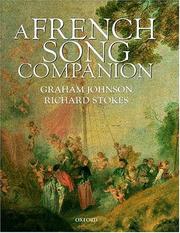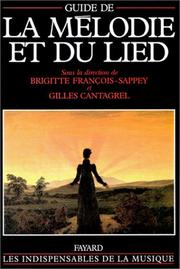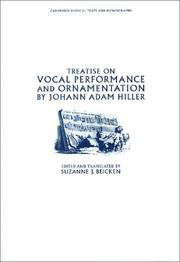| Listing 1 - 10 of 22 | << page >> |
Sort by
|
Book
ISSN: 04840828 ISBN: 0895792303 Year: 1988 Volume: v. 60-61 Publisher: Madison A-R editions
Abstract | Keywords | Export | Availability | Bookmark
 Loading...
Loading...Choose an application
- Reference Manager
- EndNote
- RefWorks (Direct export to RefWorks)
Book
ISBN: 0895792214 Year: 1987 Volume: 57 Publisher: Madison, Wisconsin : A-R Editions Inc.,
Abstract | Keywords | Export | Availability | Bookmark

ISBN: 0198164106 9780198164104 Year: 2000 Publisher: Oxford University Press
Abstract | Keywords | Export | Availability | Bookmark
 Loading...
Loading...Choose an application
- Reference Manager
- EndNote
- RefWorks (Direct export to RefWorks)
Songs, French --- History and criticism --- 78.41.2 --- Liederen, Frans --- Liedkunst
Book
ISBN: 9060103122 Year: 1979 Publisher: Naarden : Strengholt,
Abstract | Keywords | Export | Availability | Bookmark
 Loading...
Loading...Choose an application
- Reference Manager
- EndNote
- RefWorks (Direct export to RefWorks)
zangkunst --- Music --- techniek --- 411 --- Stemtechniek (algemeen) --- 78.41.1 --- stemvorming --- 639 --- Vocale didactiek - Stemtechniek --- Zang --- Didactiek --- 20e eeuw --- Nederland
Book
ISBN: 2213618992 9782213618999 Year: 2004 Volume: *21 Publisher: Paris: Fayard,
Abstract | Keywords | Export | Availability | Bookmark
 Loading...
Loading...Choose an application
- Reference Manager
- EndNote
- RefWorks (Direct export to RefWorks)
Madrigals --- Madrigaux --- History and criticism --- Histoire et critique --- Madrigalists --- Bio-bibliography --- 78.41.2 --- 78.24 --- Muziekgeschiedenis --- Italië --- 16e eeuw
Book
ISBN: 2868695450 Year: 1990 Publisher: Arles Actes Sud : Hubert Nyssen
Abstract | Keywords | Export | Availability | Bookmark
 Loading...
Loading...Choose an application
- Reference Manager
- EndNote
- RefWorks (Direct export to RefWorks)
Schumann, Robert, --- 78.21.1 Schumann --- 78.41.2 --- Duitsland --- Schumann, Robert (1810-1856) --- 19e eeuw --- Liederen

ISBN: 2213592101 9782213592107 Year: 1994 Publisher: Paris : Fayard,
Abstract | Keywords | Export | Availability | Bookmark
 Loading...
Loading...Choose an application
- Reference Manager
- EndNote
- RefWorks (Direct export to RefWorks)
muziekgeschiedenis --- Music --- liederen --- Songs --- Chansons --- Handbooks, manuals, etc. --- Guides, manuels, etc --- Analysis, appreciation --- History and criticism --- Analysis, appreciation. --- History and criticism. --- 78.41.2 --- 770 --- muziek --- musique --- Songs - Analysis, appreciation --- Songs - History and criticism --- Melodieën --- Encyclopedieën --- Liederen
Book
ISBN: 2213620725 9782213620725 Year: 2004 Publisher: Paris: Fayard,
Abstract | Keywords | Export | Availability | Bookmark
 Loading...
Loading...Choose an application
- Reference Manager
- EndNote
- RefWorks (Direct export to RefWorks)
Dans le répertoire des chanteurs, la mélodie française occupe une place précieuse et privilégiée. Prolongement de la poésie, elle suppose une compréhension intime du texte et des intentions musicales du compositeur. On ne trouve actuellement sur le marché français aucun livre qui aide les interprètes souhaitant, en France aussi bien qu'à l'étranger, aborder ce répertoire, alors même que l'ouvrage majeur de Pierre Bernac, The Interpretation of French Song, n'existe qu'en anglais. François Le Roux, qui enseigne les subtilités de ce répertoire à de nombreux jeunes chanteurs, transmet ici, avec le concours de Romain Raynaldy, le fruit de son expérience de lecteur, d'interprète et de pédagogue.Après un panorama général qui expose les principes du rapport entre la langue et la musique, les auteurs présentent une sélection du répertoire de la mélodie française et en étudient précisément cinquante-deux, donnant pour chacune, à partir du poème original et d'extraits de la partition, des directives précises pour faire jaillir du texte poético-musical sa pleine saveur.Les cinquante-deux mélodies choisies permettent de passer en revue presque deux siècles de répertoire, de ses débuts à l'époque contemporaine ; si, après l'âge romantique (Berlioz), les chefs-d'œuvre de Debussy et Fauré constituent l'apogée du genre, l'ouvrage montre qu'une floraison remarquable leur a succédé (notamment avec le groupe des Six, Poulenc s'y distinguant particulièrement) ; les plus récentes créations sont présentes également, avec des mélodies d'Henri Dutilleux, Philippe Hersant et Thierry Lancino.
Songs, French --- Chansons françaises --- History and criticism --- Histoire et critique --- Chansons françaises --- Songs --- France --- Interpretation (Phrasing, dynamics, etc.) --- Singing --- 78.41.2 --- 78.77.3 --- Songs, French - France - History and criticism. --- Frans --- Poëzie --- 19e eeuw --- 20e eeuw
Book
ISBN: 9783515096799 3515096795 Year: 2010 Volume: 66 Publisher: Stuttgart: Franz Steiner,
Abstract | Keywords | Export | Availability | Bookmark
 Loading...
Loading...Choose an application
- Reference Manager
- EndNote
- RefWorks (Direct export to RefWorks)
Song cycles --- Music --- History and criticism --- History --- Cycles, Song --- Cycles (Literature) --- Songs --- 78.41.2 --- 78.27 --- Song cycles - History and criticism --- Music - France - History --- Vocaal --- Melodieën --- 19e eeuw --- 20e eeuw --- Frankrijk

ISBN: 0521353548 0521358701 0511097417 1107111528 0511174209 0511020813 0511153880 0511328125 0511481772 128041653X 0511052405 9780511481772 9780511020810 9780511052408 9780511153884 9786610416530 6610416532 9780521353540 9780521358705 Year: 2001 Publisher: Cambridge ; New York : Cambridge University Press,
Abstract | Keywords | Export | Availability | Bookmark
 Loading...
Loading...Choose an application
- Reference Manager
- EndNote
- RefWorks (Direct export to RefWorks)
Hiller's Treatise on Vocal Performance and Ornamentation was published in Germany in 1780 and is an important manual on vocal technique and performance in the eighteenth century. Hiller was a masterful educator and was active not only as a teacher but as a critic, composer, conductor and music director. Thus, his observations served not only to raise the standards of singing in Germany, based on the Italian model, but to present complicated material, particularly ornamentation, in a manner that his peers, the middle class, could emulate. This present edition, translated with an introduction and extensive commentary by musicologist Suzanne J. Beicken, makes Hiller's treatise available for the first time in English. With its emphasis on practical aspects of ornamentation, declamation and style it will be valuable to instrumentalists as well as singers and is a significant contribution to the understanding of performance practice in the eighteenth-century.
Singing --- Methods --- Embellishment (Music) --- Early works to 1800 --- 78.41.1 --- Diminution (Music) --- Ornamentation (Music) --- Ornaments (Music) --- Music --- Performance practice (Music) --- Vocal methods --- Voice methods --- Performance --- Zangpedagogie --- 18e eeuw
| Listing 1 - 10 of 22 | << page >> |
Sort by
|

 Search
Search Feedback
Feedback About UniCat
About UniCat  Help
Help News
News